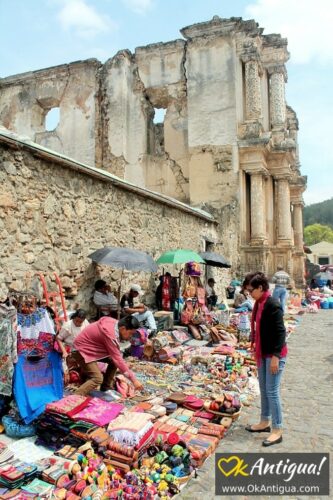The Foot of the Volcano, Left/Bottom
- Related slideshow: Step back in time in Guatemalahttp://www.bbc.com/travel/feature/20130910-antigua-rises-from-the-ashes
Belying the devastation they bring, volcanoes are bewitchingly beautiful. I was among a small group of travellers who climbed Pacaya – the other active mountain visible from Antigua – six months after it erupted in 2010, prompting President Álvaro Colom to declare a national state of emergency. Though it was calm the morning we ascended, the mountain radiated heat; a small branch dropped into a hole in the crust lit on fire before it landed. Erring on the side of caution, we stopped to admire the panorama several hundred metres short of the smouldering peak, which again resumed its sputtering in January 2013. On the charred hillside below, mangled tree branches jutted out to meet the clear blue sky. To the northwest lay Fuego’s slumbering sister, Volcán del Agua, and just beyond it, in the verdant Panchoy Valley, was Antigua, a colonial town that writer Aldous Huxley described as "one of the most romantic cities in the world".
Entering Antigua for the first time is like stepping back in time. Most power lines are buried underground, and there are no traffic signs or signals. Stucco houses with terracotta roofs dating from the 18th Century wear lion’s head knockers on their doors; each building painted its own sherbet shade of pink, yellow, orange or blue. Bougainvilleas creep over walls and succulents spill out of iron-grilled windows. Three-wheeled tuk tuks zoom down the uneven streets past the Parque Central, where brightly attired indigenous locals peddle colourful textiles, wooden wares and traditional sweets; shoe shiners loiter; and Spanish professors chat over lunch. The city’s original 16th-century design – nine streets and nine avenues organized around an elegant Spanish square – remains unchanged. Wherever you stand, you need only look up to admire one of the majestic volcanoes that surround the town, sometimes feeling precariously close.
Despite the town’s present-day beauty, Antigua has persisted through its fair share of catastrophes, from the colonial-era decimation of the indigenous population to a slew of disastrous earthquakes, the most recent of which killed 23,000 Guatemalans in 1976. The earliest-recorded tremor hit Antigua only two decades after its founding in 1543; several more in 1773 levelled it entirely, forcing the capital to move from Antigua to its current location in Guatemala City. But like a phoenix rising from the ashes, Antigua was born again in the mid-19th Century when hopeful elites pursuing coffee fortunes rebuilt the city. Since then, it has prospered – even amid a 36-year civil war that killed more than 200,000 indigenous Mayas in the late 20th Century.
Today, Antigua is the prized jewel of a country grappling with crime and corruption. As the anniversary of Del Fuego’s eruption and Pacaya’s recent rumblings remind, the nation’s larger problems are never far from this mountainous escape. Nonetheless, Antigua holds great reward for the adventurous traveller who craves historical intrigue, natural beauty and mouth-watering cuisine. Many travellers come for a day between visits to the Maya pyramids or Lake Atitlán, and are often surprised by the large number of things to do. To truly discover the best the city has to offer, start with the ghostly colonial ruins that won its designation as aUnesco World Heritage Site in 1979...¨ there is more:
 |
| Casa de los Gigantes, Antigua, Guatemala (room after room in a colonial mansion filled with Siggy´s discoveries) |



























_-_James_Tissot_-_overall.jpg)















1 comment:
Wonderfully informative post, Len. Thank you.
Post a Comment